Oral Health Disparities: Indigenous Australians and Colonization
VerifiedAdded on 2022/10/15
|8
|2214
|14
Essay
AI Summary
This essay provides a comprehensive overview of oral health among Indigenous Australians, highlighting significant disparities compared to non-Indigenous populations. It begins by defining oral health and common diseases, such as tooth decay and gum disease, and then presents historical data illustrating the decline in oral health among Aboriginal and Torres Strait Islander peoples since the 1970s. The essay delves into the prevalence of oral health diseases, including high rates of caries, tooth loss, and periodontal diseases, particularly in rural and remote areas. It examines the impact of colonization, including discrimination and dietary changes, and discusses how socioeconomic factors like education, income, and employment contribute to these health issues. Furthermore, the essay explores cultural implications and barriers, such as the cost of services and lack of awareness, that hinder effective oral health interventions. The conclusion emphasizes the need to address these multifaceted challenges to improve oral health outcomes for Indigenous Australians, referencing key studies and reports to support its arguments.
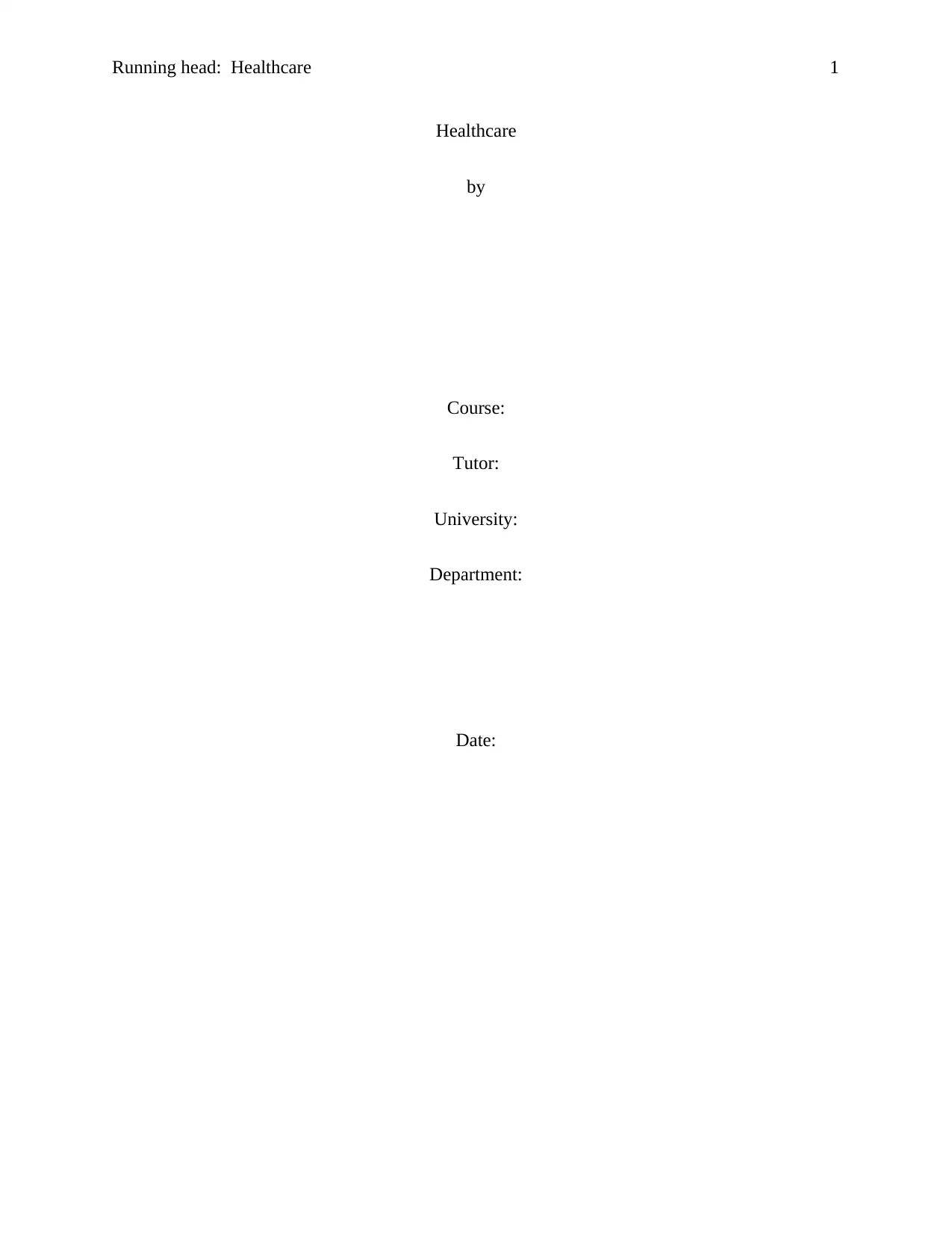
Running head: Healthcare 1
Healthcare
by
Course:
Tutor:
University:
Department:
Date:
Healthcare
by
Course:
Tutor:
University:
Department:
Date:
Paraphrase This Document
Need a fresh take? Get an instant paraphrase of this document with our AI Paraphraser
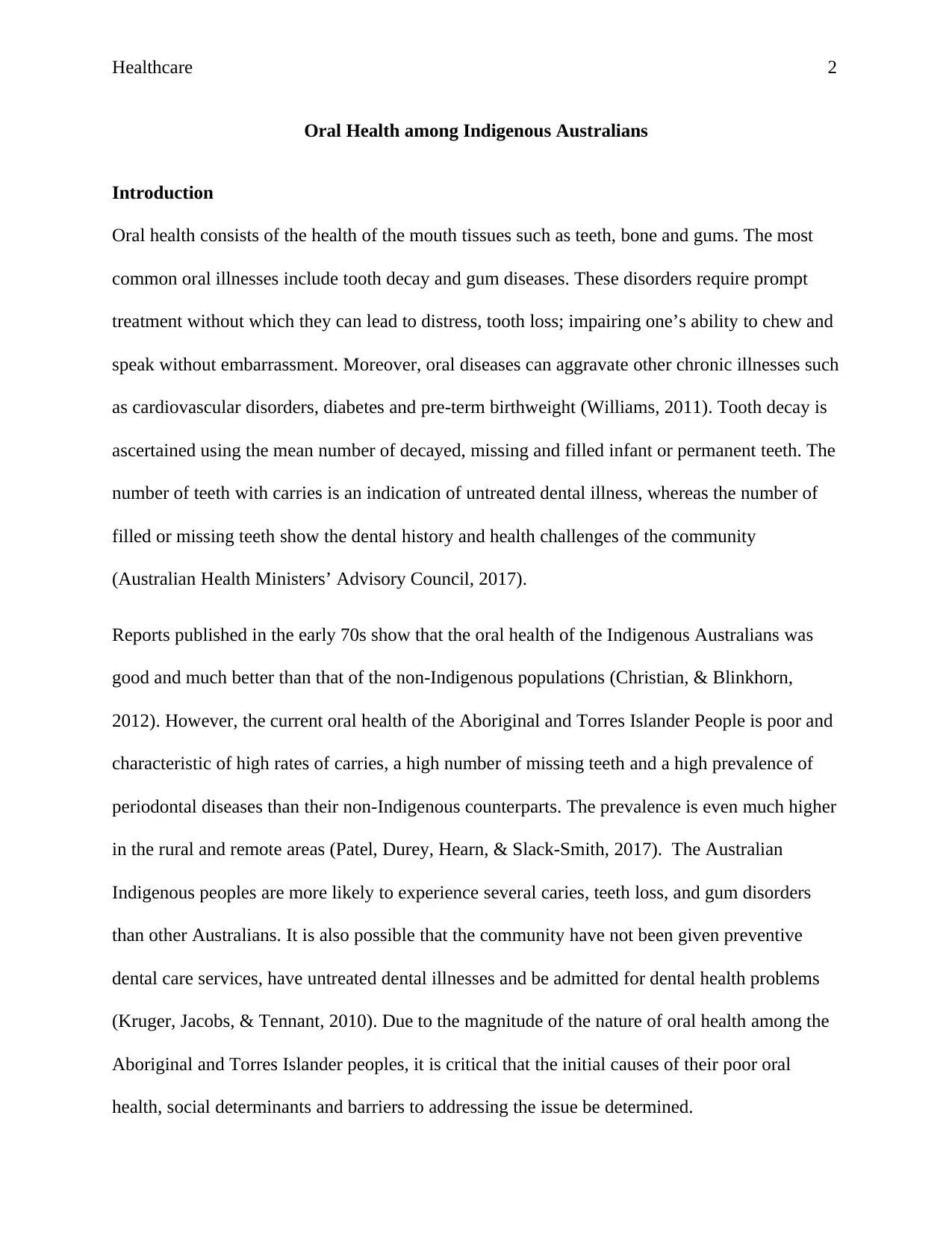
Healthcare 2
Oral Health among Indigenous Australians
Introduction
Oral health consists of the health of the mouth tissues such as teeth, bone and gums. The most
common oral illnesses include tooth decay and gum diseases. These disorders require prompt
treatment without which they can lead to distress, tooth loss; impairing one’s ability to chew and
speak without embarrassment. Moreover, oral diseases can aggravate other chronic illnesses such
as cardiovascular disorders, diabetes and pre-term birthweight (Williams, 2011). Tooth decay is
ascertained using the mean number of decayed, missing and filled infant or permanent teeth. The
number of teeth with carries is an indication of untreated dental illness, whereas the number of
filled or missing teeth show the dental history and health challenges of the community
(Australian Health Ministers’ Advisory Council, 2017).
Reports published in the early 70s show that the oral health of the Indigenous Australians was
good and much better than that of the non-Indigenous populations (Christian, & Blinkhorn,
2012). However, the current oral health of the Aboriginal and Torres Islander People is poor and
characteristic of high rates of carries, a high number of missing teeth and a high prevalence of
periodontal diseases than their non-Indigenous counterparts. The prevalence is even much higher
in the rural and remote areas (Patel, Durey, Hearn, & Slack‐Smith, 2017). The Australian
Indigenous peoples are more likely to experience several caries, teeth loss, and gum disorders
than other Australians. It is also possible that the community have not been given preventive
dental care services, have untreated dental illnesses and be admitted for dental health problems
(Kruger, Jacobs, & Tennant, 2010). Due to the magnitude of the nature of oral health among the
Aboriginal and Torres Islander peoples, it is critical that the initial causes of their poor oral
health, social determinants and barriers to addressing the issue be determined.
Oral Health among Indigenous Australians
Introduction
Oral health consists of the health of the mouth tissues such as teeth, bone and gums. The most
common oral illnesses include tooth decay and gum diseases. These disorders require prompt
treatment without which they can lead to distress, tooth loss; impairing one’s ability to chew and
speak without embarrassment. Moreover, oral diseases can aggravate other chronic illnesses such
as cardiovascular disorders, diabetes and pre-term birthweight (Williams, 2011). Tooth decay is
ascertained using the mean number of decayed, missing and filled infant or permanent teeth. The
number of teeth with carries is an indication of untreated dental illness, whereas the number of
filled or missing teeth show the dental history and health challenges of the community
(Australian Health Ministers’ Advisory Council, 2017).
Reports published in the early 70s show that the oral health of the Indigenous Australians was
good and much better than that of the non-Indigenous populations (Christian, & Blinkhorn,
2012). However, the current oral health of the Aboriginal and Torres Islander People is poor and
characteristic of high rates of carries, a high number of missing teeth and a high prevalence of
periodontal diseases than their non-Indigenous counterparts. The prevalence is even much higher
in the rural and remote areas (Patel, Durey, Hearn, & Slack‐Smith, 2017). The Australian
Indigenous peoples are more likely to experience several caries, teeth loss, and gum disorders
than other Australians. It is also possible that the community have not been given preventive
dental care services, have untreated dental illnesses and be admitted for dental health problems
(Kruger, Jacobs, & Tennant, 2010). Due to the magnitude of the nature of oral health among the
Aboriginal and Torres Islander peoples, it is critical that the initial causes of their poor oral
health, social determinants and barriers to addressing the issue be determined.
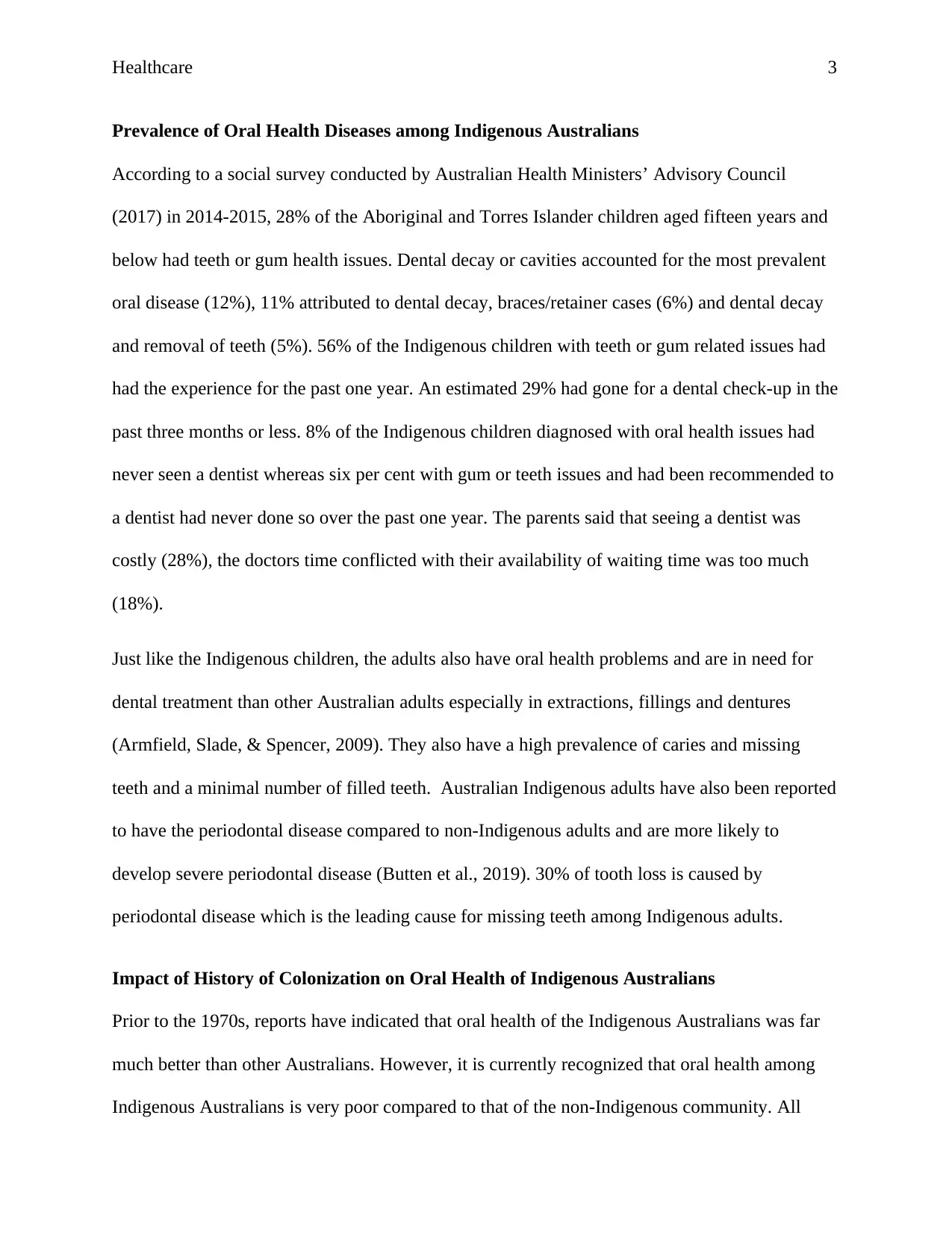
Healthcare 3
Prevalence of Oral Health Diseases among Indigenous Australians
According to a social survey conducted by Australian Health Ministers’ Advisory Council
(2017) in 2014-2015, 28% of the Aboriginal and Torres Islander children aged fifteen years and
below had teeth or gum health issues. Dental decay or cavities accounted for the most prevalent
oral disease (12%), 11% attributed to dental decay, braces/retainer cases (6%) and dental decay
and removal of teeth (5%). 56% of the Indigenous children with teeth or gum related issues had
had the experience for the past one year. An estimated 29% had gone for a dental check-up in the
past three months or less. 8% of the Indigenous children diagnosed with oral health issues had
never seen a dentist whereas six per cent with gum or teeth issues and had been recommended to
a dentist had never done so over the past one year. The parents said that seeing a dentist was
costly (28%), the doctors time conflicted with their availability of waiting time was too much
(18%).
Just like the Indigenous children, the adults also have oral health problems and are in need for
dental treatment than other Australian adults especially in extractions, fillings and dentures
(Armfield, Slade, & Spencer, 2009). They also have a high prevalence of caries and missing
teeth and a minimal number of filled teeth. Australian Indigenous adults have also been reported
to have the periodontal disease compared to non-Indigenous adults and are more likely to
develop severe periodontal disease (Butten et al., 2019). 30% of tooth loss is caused by
periodontal disease which is the leading cause for missing teeth among Indigenous adults.
Impact of History of Colonization on Oral Health of Indigenous Australians
Prior to the 1970s, reports have indicated that oral health of the Indigenous Australians was far
much better than other Australians. However, it is currently recognized that oral health among
Indigenous Australians is very poor compared to that of the non-Indigenous community. All
Prevalence of Oral Health Diseases among Indigenous Australians
According to a social survey conducted by Australian Health Ministers’ Advisory Council
(2017) in 2014-2015, 28% of the Aboriginal and Torres Islander children aged fifteen years and
below had teeth or gum health issues. Dental decay or cavities accounted for the most prevalent
oral disease (12%), 11% attributed to dental decay, braces/retainer cases (6%) and dental decay
and removal of teeth (5%). 56% of the Indigenous children with teeth or gum related issues had
had the experience for the past one year. An estimated 29% had gone for a dental check-up in the
past three months or less. 8% of the Indigenous children diagnosed with oral health issues had
never seen a dentist whereas six per cent with gum or teeth issues and had been recommended to
a dentist had never done so over the past one year. The parents said that seeing a dentist was
costly (28%), the doctors time conflicted with their availability of waiting time was too much
(18%).
Just like the Indigenous children, the adults also have oral health problems and are in need for
dental treatment than other Australian adults especially in extractions, fillings and dentures
(Armfield, Slade, & Spencer, 2009). They also have a high prevalence of caries and missing
teeth and a minimal number of filled teeth. Australian Indigenous adults have also been reported
to have the periodontal disease compared to non-Indigenous adults and are more likely to
develop severe periodontal disease (Butten et al., 2019). 30% of tooth loss is caused by
periodontal disease which is the leading cause for missing teeth among Indigenous adults.
Impact of History of Colonization on Oral Health of Indigenous Australians
Prior to the 1970s, reports have indicated that oral health of the Indigenous Australians was far
much better than other Australians. However, it is currently recognized that oral health among
Indigenous Australians is very poor compared to that of the non-Indigenous community. All
⊘ This is a preview!⊘
Do you want full access?
Subscribe today to unlock all pages.

Trusted by 1+ million students worldwide
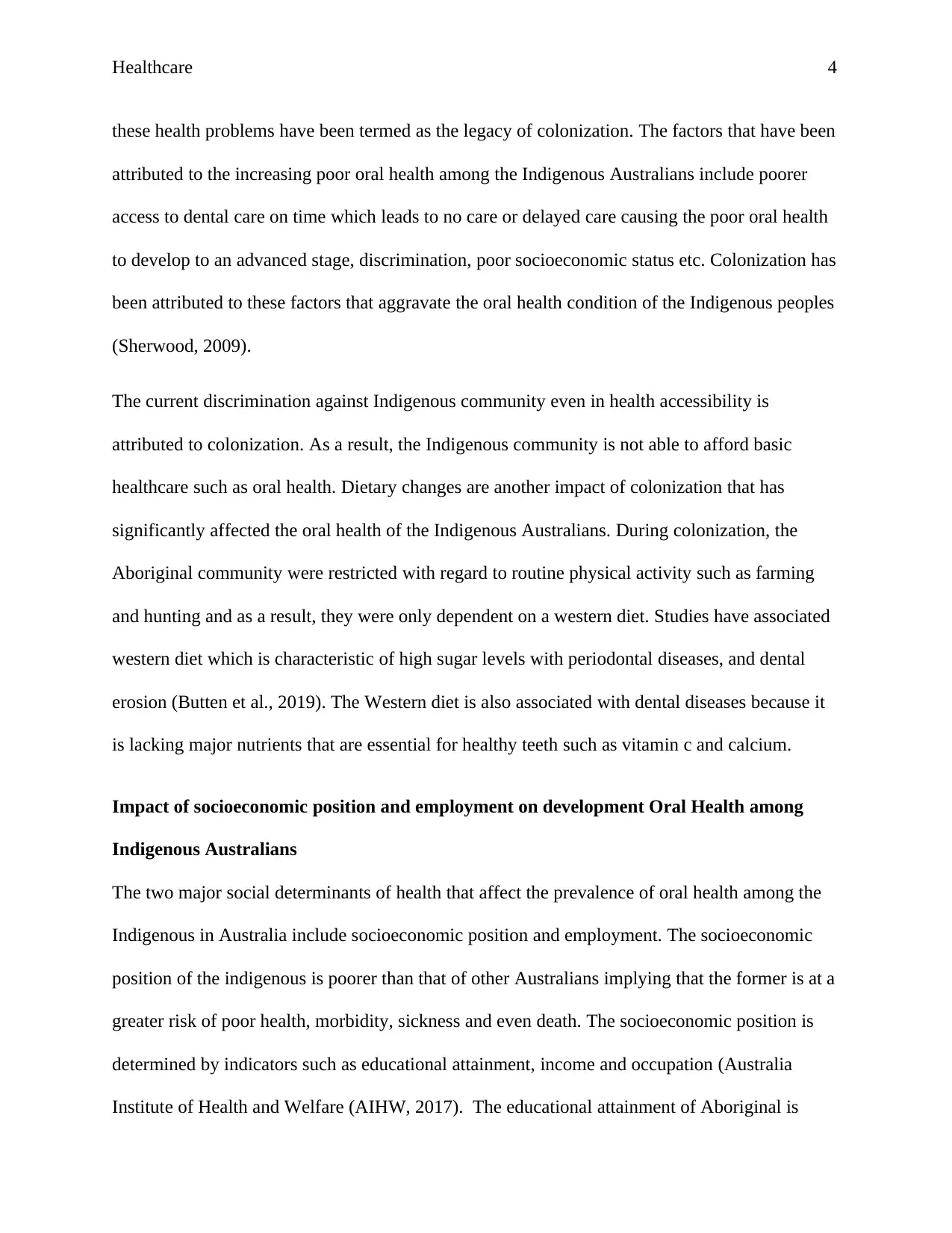
Healthcare 4
these health problems have been termed as the legacy of colonization. The factors that have been
attributed to the increasing poor oral health among the Indigenous Australians include poorer
access to dental care on time which leads to no care or delayed care causing the poor oral health
to develop to an advanced stage, discrimination, poor socioeconomic status etc. Colonization has
been attributed to these factors that aggravate the oral health condition of the Indigenous peoples
(Sherwood, 2009).
The current discrimination against Indigenous community even in health accessibility is
attributed to colonization. As a result, the Indigenous community is not able to afford basic
healthcare such as oral health. Dietary changes are another impact of colonization that has
significantly affected the oral health of the Indigenous Australians. During colonization, the
Aboriginal community were restricted with regard to routine physical activity such as farming
and hunting and as a result, they were only dependent on a western diet. Studies have associated
western diet which is characteristic of high sugar levels with periodontal diseases, and dental
erosion (Butten et al., 2019). The Western diet is also associated with dental diseases because it
is lacking major nutrients that are essential for healthy teeth such as vitamin c and calcium.
Impact of socioeconomic position and employment on development Oral Health among
Indigenous Australians
The two major social determinants of health that affect the prevalence of oral health among the
Indigenous in Australia include socioeconomic position and employment. The socioeconomic
position of the indigenous is poorer than that of other Australians implying that the former is at a
greater risk of poor health, morbidity, sickness and even death. The socioeconomic position is
determined by indicators such as educational attainment, income and occupation (Australia
Institute of Health and Welfare (AIHW, 2017). The educational attainment of Aboriginal is
these health problems have been termed as the legacy of colonization. The factors that have been
attributed to the increasing poor oral health among the Indigenous Australians include poorer
access to dental care on time which leads to no care or delayed care causing the poor oral health
to develop to an advanced stage, discrimination, poor socioeconomic status etc. Colonization has
been attributed to these factors that aggravate the oral health condition of the Indigenous peoples
(Sherwood, 2009).
The current discrimination against Indigenous community even in health accessibility is
attributed to colonization. As a result, the Indigenous community is not able to afford basic
healthcare such as oral health. Dietary changes are another impact of colonization that has
significantly affected the oral health of the Indigenous Australians. During colonization, the
Aboriginal community were restricted with regard to routine physical activity such as farming
and hunting and as a result, they were only dependent on a western diet. Studies have associated
western diet which is characteristic of high sugar levels with periodontal diseases, and dental
erosion (Butten et al., 2019). The Western diet is also associated with dental diseases because it
is lacking major nutrients that are essential for healthy teeth such as vitamin c and calcium.
Impact of socioeconomic position and employment on development Oral Health among
Indigenous Australians
The two major social determinants of health that affect the prevalence of oral health among the
Indigenous in Australia include socioeconomic position and employment. The socioeconomic
position of the indigenous is poorer than that of other Australians implying that the former is at a
greater risk of poor health, morbidity, sickness and even death. The socioeconomic position is
determined by indicators such as educational attainment, income and occupation (Australia
Institute of Health and Welfare (AIHW, 2017). The educational attainment of Aboriginal is
Paraphrase This Document
Need a fresh take? Get an instant paraphrase of this document with our AI Paraphraser
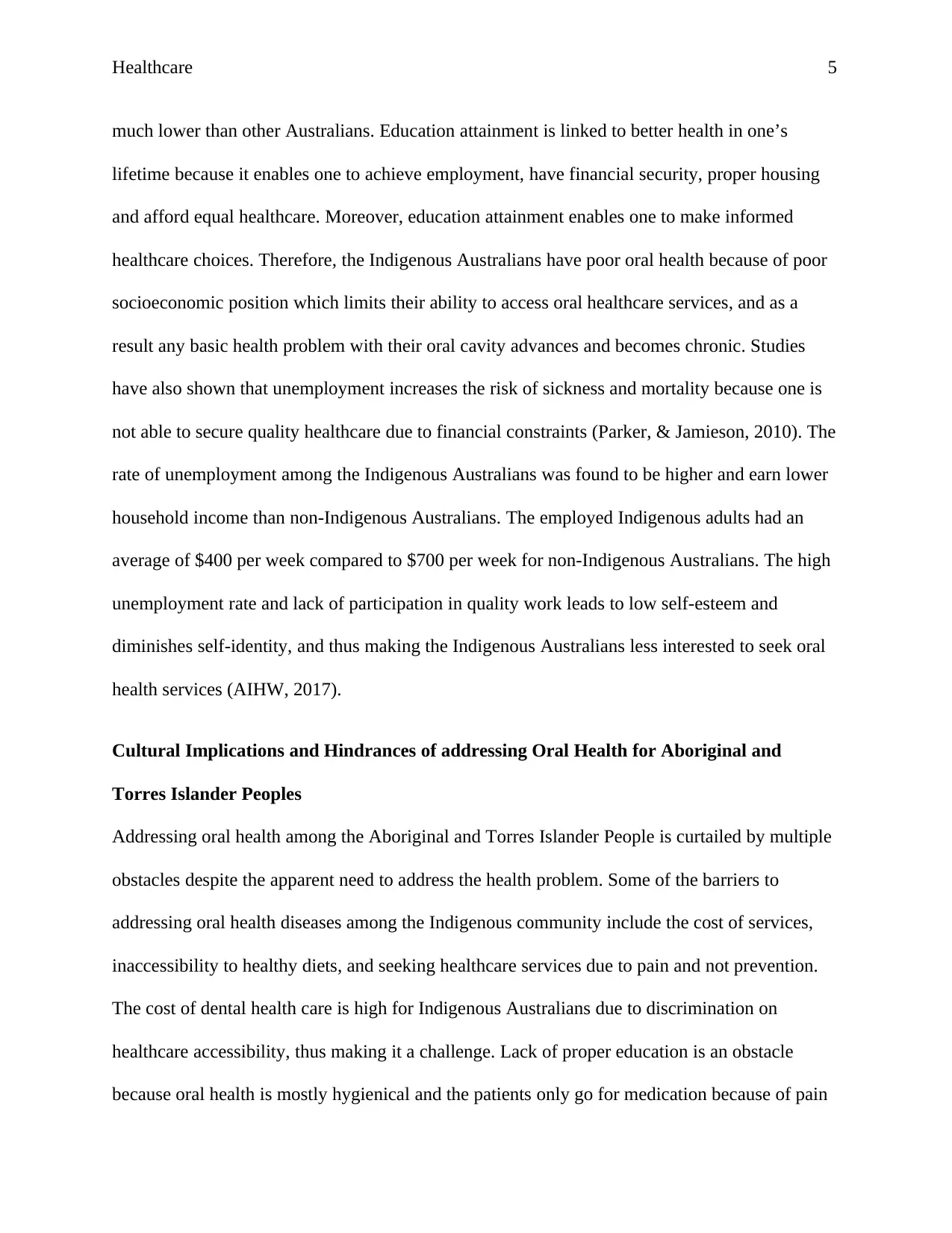
Healthcare 5
much lower than other Australians. Education attainment is linked to better health in one’s
lifetime because it enables one to achieve employment, have financial security, proper housing
and afford equal healthcare. Moreover, education attainment enables one to make informed
healthcare choices. Therefore, the Indigenous Australians have poor oral health because of poor
socioeconomic position which limits their ability to access oral healthcare services, and as a
result any basic health problem with their oral cavity advances and becomes chronic. Studies
have also shown that unemployment increases the risk of sickness and mortality because one is
not able to secure quality healthcare due to financial constraints (Parker, & Jamieson, 2010). The
rate of unemployment among the Indigenous Australians was found to be higher and earn lower
household income than non-Indigenous Australians. The employed Indigenous adults had an
average of $400 per week compared to $700 per week for non-Indigenous Australians. The high
unemployment rate and lack of participation in quality work leads to low self-esteem and
diminishes self-identity, and thus making the Indigenous Australians less interested to seek oral
health services (AIHW, 2017).
Cultural Implications and Hindrances of addressing Oral Health for Aboriginal and
Torres Islander Peoples
Addressing oral health among the Aboriginal and Torres Islander People is curtailed by multiple
obstacles despite the apparent need to address the health problem. Some of the barriers to
addressing oral health diseases among the Indigenous community include the cost of services,
inaccessibility to healthy diets, and seeking healthcare services due to pain and not prevention.
The cost of dental health care is high for Indigenous Australians due to discrimination on
healthcare accessibility, thus making it a challenge. Lack of proper education is an obstacle
because oral health is mostly hygienical and the patients only go for medication because of pain
much lower than other Australians. Education attainment is linked to better health in one’s
lifetime because it enables one to achieve employment, have financial security, proper housing
and afford equal healthcare. Moreover, education attainment enables one to make informed
healthcare choices. Therefore, the Indigenous Australians have poor oral health because of poor
socioeconomic position which limits their ability to access oral healthcare services, and as a
result any basic health problem with their oral cavity advances and becomes chronic. Studies
have also shown that unemployment increases the risk of sickness and mortality because one is
not able to secure quality healthcare due to financial constraints (Parker, & Jamieson, 2010). The
rate of unemployment among the Indigenous Australians was found to be higher and earn lower
household income than non-Indigenous Australians. The employed Indigenous adults had an
average of $400 per week compared to $700 per week for non-Indigenous Australians. The high
unemployment rate and lack of participation in quality work leads to low self-esteem and
diminishes self-identity, and thus making the Indigenous Australians less interested to seek oral
health services (AIHW, 2017).
Cultural Implications and Hindrances of addressing Oral Health for Aboriginal and
Torres Islander Peoples
Addressing oral health among the Aboriginal and Torres Islander People is curtailed by multiple
obstacles despite the apparent need to address the health problem. Some of the barriers to
addressing oral health diseases among the Indigenous community include the cost of services,
inaccessibility to healthy diets, and seeking healthcare services due to pain and not prevention.
The cost of dental health care is high for Indigenous Australians due to discrimination on
healthcare accessibility, thus making it a challenge. Lack of proper education is an obstacle
because oral health is mostly hygienical and the patients only go for medication because of pain
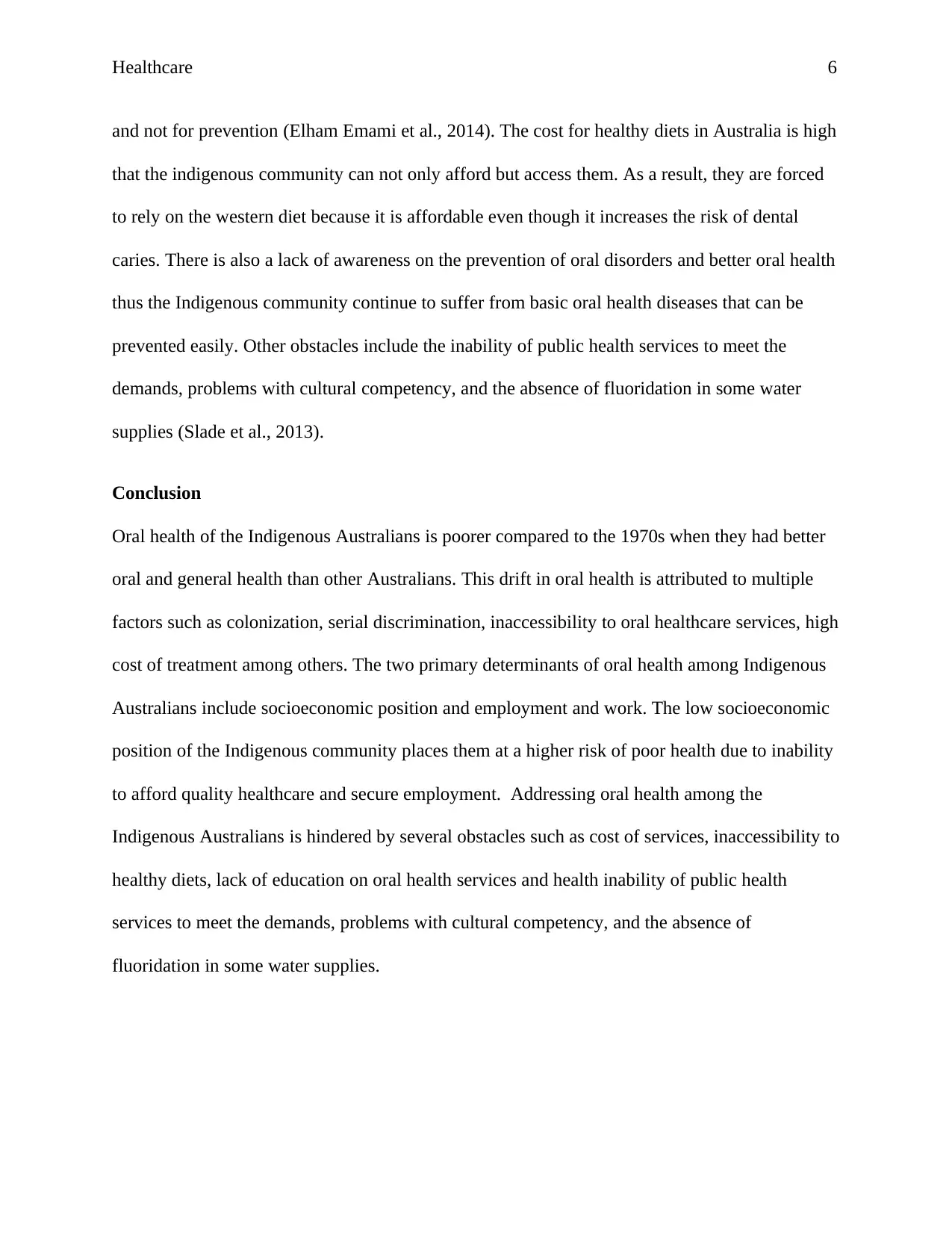
Healthcare 6
and not for prevention (Elham Emami et al., 2014). The cost for healthy diets in Australia is high
that the indigenous community can not only afford but access them. As a result, they are forced
to rely on the western diet because it is affordable even though it increases the risk of dental
caries. There is also a lack of awareness on the prevention of oral disorders and better oral health
thus the Indigenous community continue to suffer from basic oral health diseases that can be
prevented easily. Other obstacles include the inability of public health services to meet the
demands, problems with cultural competency, and the absence of fluoridation in some water
supplies (Slade et al., 2013).
Conclusion
Oral health of the Indigenous Australians is poorer compared to the 1970s when they had better
oral and general health than other Australians. This drift in oral health is attributed to multiple
factors such as colonization, serial discrimination, inaccessibility to oral healthcare services, high
cost of treatment among others. The two primary determinants of oral health among Indigenous
Australians include socioeconomic position and employment and work. The low socioeconomic
position of the Indigenous community places them at a higher risk of poor health due to inability
to afford quality healthcare and secure employment. Addressing oral health among the
Indigenous Australians is hindered by several obstacles such as cost of services, inaccessibility to
healthy diets, lack of education on oral health services and health inability of public health
services to meet the demands, problems with cultural competency, and the absence of
fluoridation in some water supplies.
and not for prevention (Elham Emami et al., 2014). The cost for healthy diets in Australia is high
that the indigenous community can not only afford but access them. As a result, they are forced
to rely on the western diet because it is affordable even though it increases the risk of dental
caries. There is also a lack of awareness on the prevention of oral disorders and better oral health
thus the Indigenous community continue to suffer from basic oral health diseases that can be
prevented easily. Other obstacles include the inability of public health services to meet the
demands, problems with cultural competency, and the absence of fluoridation in some water
supplies (Slade et al., 2013).
Conclusion
Oral health of the Indigenous Australians is poorer compared to the 1970s when they had better
oral and general health than other Australians. This drift in oral health is attributed to multiple
factors such as colonization, serial discrimination, inaccessibility to oral healthcare services, high
cost of treatment among others. The two primary determinants of oral health among Indigenous
Australians include socioeconomic position and employment and work. The low socioeconomic
position of the Indigenous community places them at a higher risk of poor health due to inability
to afford quality healthcare and secure employment. Addressing oral health among the
Indigenous Australians is hindered by several obstacles such as cost of services, inaccessibility to
healthy diets, lack of education on oral health services and health inability of public health
services to meet the demands, problems with cultural competency, and the absence of
fluoridation in some water supplies.
⊘ This is a preview!⊘
Do you want full access?
Subscribe today to unlock all pages.

Trusted by 1+ million students worldwide
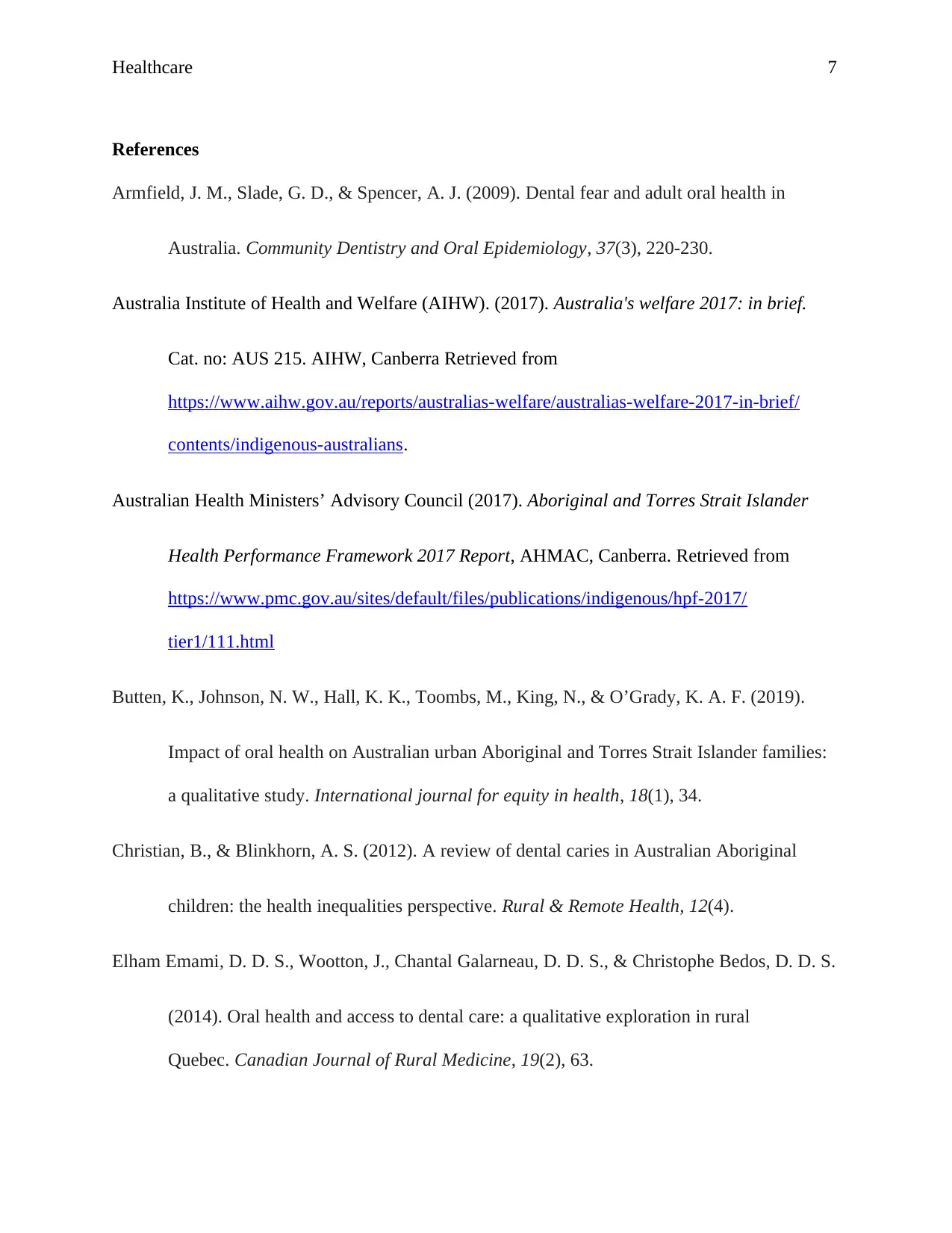
Healthcare 7
References
Armfield, J. M., Slade, G. D., & Spencer, A. J. (2009). Dental fear and adult oral health in
Australia. Community Dentistry and Oral Epidemiology, 37(3), 220-230.
Australia Institute of Health and Welfare (AIHW). (2017). Australia's welfare 2017: in brief.
Cat. no: AUS 215. AIHW, Canberra Retrieved from
https://www.aihw.gov.au/reports/australias-welfare/australias-welfare-2017-in-brief/
contents/indigenous-australians.
Australian Health Ministers’ Advisory Council (2017). Aboriginal and Torres Strait Islander
Health Performance Framework 2017 Report, AHMAC, Canberra. Retrieved from
https://www.pmc.gov.au/sites/default/files/publications/indigenous/hpf-2017/
tier1/111.html
Butten, K., Johnson, N. W., Hall, K. K., Toombs, M., King, N., & O’Grady, K. A. F. (2019).
Impact of oral health on Australian urban Aboriginal and Torres Strait Islander families:
a qualitative study. International journal for equity in health, 18(1), 34.
Christian, B., & Blinkhorn, A. S. (2012). A review of dental caries in Australian Aboriginal
children: the health inequalities perspective. Rural & Remote Health, 12(4).
Elham Emami, D. D. S., Wootton, J., Chantal Galarneau, D. D. S., & Christophe Bedos, D. D. S.
(2014). Oral health and access to dental care: a qualitative exploration in rural
Quebec. Canadian Journal of Rural Medicine, 19(2), 63.
References
Armfield, J. M., Slade, G. D., & Spencer, A. J. (2009). Dental fear and adult oral health in
Australia. Community Dentistry and Oral Epidemiology, 37(3), 220-230.
Australia Institute of Health and Welfare (AIHW). (2017). Australia's welfare 2017: in brief.
Cat. no: AUS 215. AIHW, Canberra Retrieved from
https://www.aihw.gov.au/reports/australias-welfare/australias-welfare-2017-in-brief/
contents/indigenous-australians.
Australian Health Ministers’ Advisory Council (2017). Aboriginal and Torres Strait Islander
Health Performance Framework 2017 Report, AHMAC, Canberra. Retrieved from
https://www.pmc.gov.au/sites/default/files/publications/indigenous/hpf-2017/
tier1/111.html
Butten, K., Johnson, N. W., Hall, K. K., Toombs, M., King, N., & O’Grady, K. A. F. (2019).
Impact of oral health on Australian urban Aboriginal and Torres Strait Islander families:
a qualitative study. International journal for equity in health, 18(1), 34.
Christian, B., & Blinkhorn, A. S. (2012). A review of dental caries in Australian Aboriginal
children: the health inequalities perspective. Rural & Remote Health, 12(4).
Elham Emami, D. D. S., Wootton, J., Chantal Galarneau, D. D. S., & Christophe Bedos, D. D. S.
(2014). Oral health and access to dental care: a qualitative exploration in rural
Quebec. Canadian Journal of Rural Medicine, 19(2), 63.
Paraphrase This Document
Need a fresh take? Get an instant paraphrase of this document with our AI Paraphraser
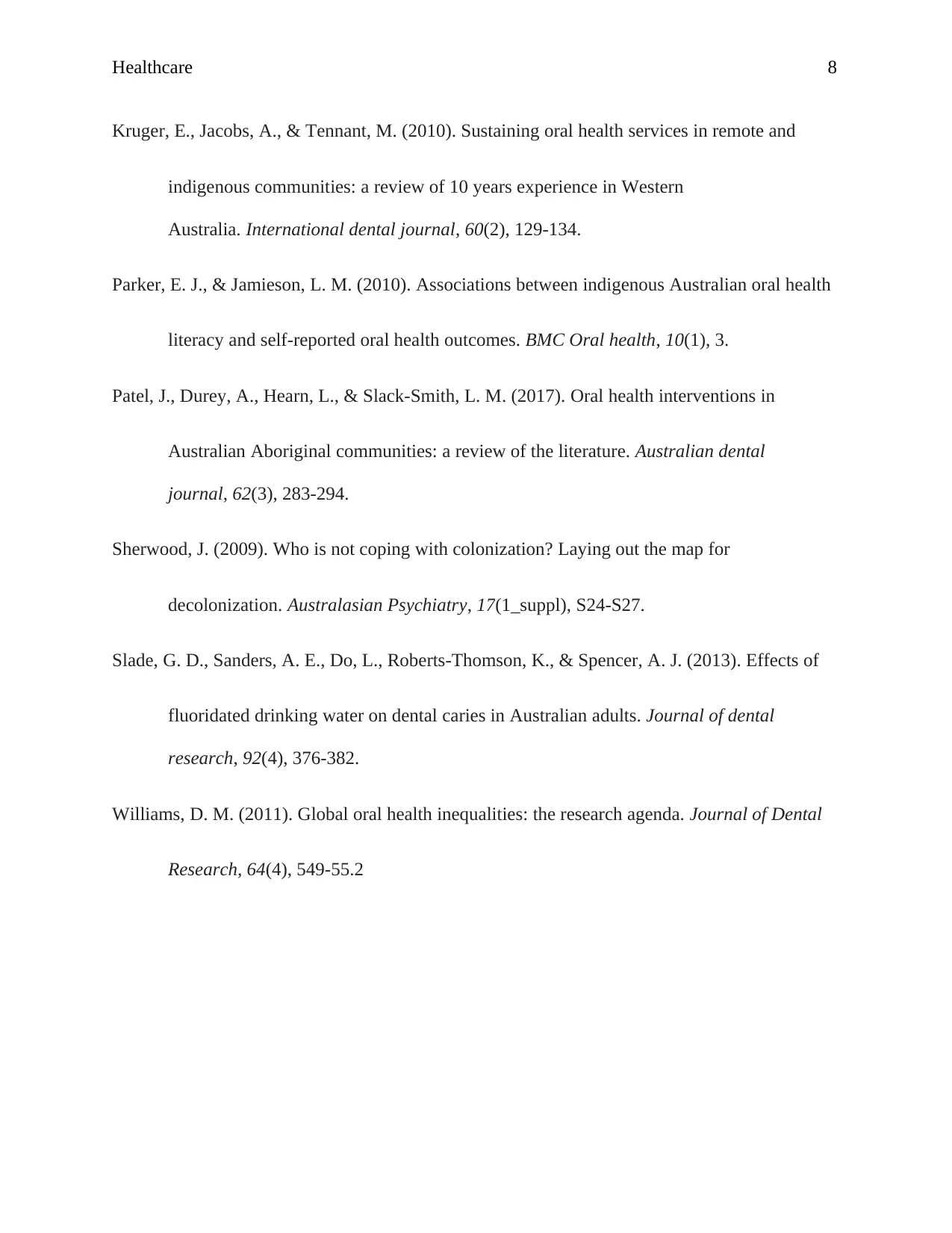
Healthcare 8
Kruger, E., Jacobs, A., & Tennant, M. (2010). Sustaining oral health services in remote and
indigenous communities: a review of 10 years experience in Western
Australia. International dental journal, 60(2), 129-134.
Parker, E. J., & Jamieson, L. M. (2010). Associations between indigenous Australian oral health
literacy and self-reported oral health outcomes. BMC Oral health, 10(1), 3.
Patel, J., Durey, A., Hearn, L., & Slack‐Smith, L. M. (2017). Oral health interventions in
Australian Aboriginal communities: a review of the literature. Australian dental
journal, 62(3), 283-294.
Sherwood, J. (2009). Who is not coping with colonization? Laying out the map for
decolonization. Australasian Psychiatry, 17(1_suppl), S24-S27.
Slade, G. D., Sanders, A. E., Do, L., Roberts-Thomson, K., & Spencer, A. J. (2013). Effects of
fluoridated drinking water on dental caries in Australian adults. Journal of dental
research, 92(4), 376-382.
Williams, D. M. (2011). Global oral health inequalities: the research agenda. Journal of Dental
Research, 64(4), 549-55.2
Kruger, E., Jacobs, A., & Tennant, M. (2010). Sustaining oral health services in remote and
indigenous communities: a review of 10 years experience in Western
Australia. International dental journal, 60(2), 129-134.
Parker, E. J., & Jamieson, L. M. (2010). Associations between indigenous Australian oral health
literacy and self-reported oral health outcomes. BMC Oral health, 10(1), 3.
Patel, J., Durey, A., Hearn, L., & Slack‐Smith, L. M. (2017). Oral health interventions in
Australian Aboriginal communities: a review of the literature. Australian dental
journal, 62(3), 283-294.
Sherwood, J. (2009). Who is not coping with colonization? Laying out the map for
decolonization. Australasian Psychiatry, 17(1_suppl), S24-S27.
Slade, G. D., Sanders, A. E., Do, L., Roberts-Thomson, K., & Spencer, A. J. (2013). Effects of
fluoridated drinking water on dental caries in Australian adults. Journal of dental
research, 92(4), 376-382.
Williams, D. M. (2011). Global oral health inequalities: the research agenda. Journal of Dental
Research, 64(4), 549-55.2
1 out of 8
Related Documents
Your All-in-One AI-Powered Toolkit for Academic Success.
+13062052269
info@desklib.com
Available 24*7 on WhatsApp / Email
![[object Object]](/_next/static/media/star-bottom.7253800d.svg)
Unlock your academic potential
Copyright © 2020–2025 A2Z Services. All Rights Reserved. Developed and managed by ZUCOL.





